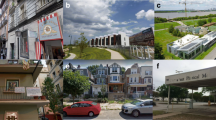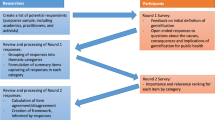Abstract
Straddling apartheid’s buffer zone between Soweto and Johannesburg South lies a newly demarcated municipal ward. Described by its councillor as a miniature “Rainbow Nation”, it is a provocative site for stitching together the apartheid city and for exploring postapartheid socio-spatial change at a mesoscale between the neighbourhood and the city. Qualitative fieldwork reveals that reconfigured political boundaries are just one of many boundary-making projects unfolding at multiple scales. Formerly white suburbs are racially desegregated, but have also witnessed white flight out of neighbourhoods, institutions and public space, and some enclavisation through gated complexes and private schools. Microgeographies of racially coded space inform everyday life, now often attributed to “cultural difference”. Black residents produce connections to other parts of the city through relationships to family and friends in townships and create new communities in developer-built subdivisions. Infrastructural distinctions between “township” and “suburb” are blurring, with new and old infrastructural inequalities and entanglements emerging. Not all discourses and practices of belonging and exclusion can be mapped onto racial categories or racialised space: new alliances based on property ownership, class and security are emerging, along with new shared “others”. This site demonstrates how new boundary placements overlay and cathect existing boundaries and their repertoires of belonging and exclusion in ambivalent ways.

Similar content being viewed by others
Notes
This was not necessarily true: the first suburbs in the area, such as Mondeor developed by a private township owner from the late 1940s, had few amenities and basic infrastructure for years (clippings from resident Noel Thornton).
References
Ballard, R. (2010). ‘Slaughter in the suburbs’: Livestock slaughter and race in post-apartheid cities. Ethnic and Racial Studies, 33(6), 1069–1087. https://doi.org/10.1080/01419870903477320.
Beavon, K. (1997). Johannesburg: A city and metropolitan area in transformation. In C. Rakodi (Ed.), The Urban Challenge in Africa: Growth and Management of Its Large Cities. (pp. 150–191). United Nations University Press. http://archive.unu.edu/unupress/unupbooks/uu26ue/uu26ue0h.htm. Accessed 20 Oct 2020.
Beavon, K. (2004). Johannesburg: The Making and Shaping of the City. (1st ed.). Unisa Press.
Bremner, L. (2010). Writing the City into Being: Essays on Johannesburg, 1998–2008. Fourthwall Books.
Cesafsky, L. (2017). How to mend a fragmented city: A critique of “infrastructural solidarity.” International Journal of Urban and Regional Research, 41(1), 145–161. https://doi.org/10.1111/1468-2427.12447.
Chipkin, I., & Meny-Gibert, S. (2013). Introduction: New and contemporary spaces in South Africa. Social Dynamics, 39(2), 151–158. https://doi.org/10.1080/02533952.2013.796126.
Christopher, A. J. (2001). Urban segregation in post-apartheid South Africa. Urban Studies, 38(3), 449–466.
Clarno, A. (2013). Rescaling white space in post-apartheid Johannesburg. Antipode, 45(5), 1190–1212. https://doi.org/10.1111/anti.12015.
Crankshaw, O. (2008). Race, Space and the Post-Fordist Spatial Order of Johannesburg. Urban Studies, 45(8), 1692–1711. https://doi.org/10.1177/0042098008091497.
Dirsuweit, T., & Wafer, A. (2006). Scale, governance and the maintenance of privileged control: The case of road closures in Johannesburg’s northern suburbs. Urban Forum, 17(4), 327–352. https://doi.org/10.1007/BF02681236.
Duca, F. (2013). New community in a new space: Artificial, natural, created, contested. An idea from a golf estate in Johannesburg. Social Dynamics, 39(2), 191–209. https://doi.org/10.1080/02533952.2013.796122.
Ferguson, J. (2015). Give a Man a Fish: Reflections on the New Politics of Distribution. Duke University Press.
Hamann, C., & Ballard, R. (2017). Dimensions of diversity in Gauteng. GCRO Map of the Month. Gauteng City Region Observatory.https://gcro.ac.za/outputs/map-of-the-month/detail/dimensions-of-diversity-in-gauteng/.
Harrison, P., & Todes, A. (2015). Spatial transformations in a “loosening state”: South Africa in a comparative perspective. Geoforum, 61(May), 148–162. https://doi.org/10.1016/j.geoforum.2015.03.003.
Harrison, P., & Zack, T. (2014a). The wrong side of the mining belt? Spatial transformations and identities in Johannesburg’s southern suburbs. In P. Harrison, G. Gotz, A. Todes, & C. Wray (Eds.), Changing Space, Changing City: Johannesburg after Apartheid. (pp. 269–292). Wits University Press.
Harrison, P., & Zack, T. (2014b). Between the ordinary and the extraordinary: Socio-spatial transformations in the “Old South” of Johannesburg. South African Geographical Journal, 96(2), 180–197. https://doi.org/10.1080/03736245.2014.924863
Hart, G. H. T. (1968). An Introduction to the Anatomy of Johannesburg’s Southern Suburbs. South African Geographical Journal, 50(1), 65–72. https://doi.org/10.1080/03736245.1968.10559433.
Huchzermeyer, M., & Karam, A. (Eds.). (2006). Informal Settlements: A Perpetual Challenge? UCT Press.
Katumba, S. (2019). Gauteng’s ward level racial diversity: 2018. GCRO Map of the Month. Johannesburg: Gauteng City Region Observatory. https://www.gcro.ac.za/outputs/map-of-the-month/detail/gautengs-ward-level-racial-diversity-2018/.
Kracker Selzer, A., & Heller, P. (2010). The spatial dynamics of middle-class formation in postapartheid South Africa: Enclavization and fragmentation in Johannesburg. Political Power and Social Theory, 21, 171–208.
Landman, K. (2004). Gated communities in South Africa: The challenge for spatial planning and land use management. Town Planning Review, 75(2), 151–172. https://doi.org/10.3828/tpr.75.2.3.
Lemanski, C. (2006). Desegregation and integration as linked or distinct? Evidence from a previously “white” suburb in post-apartheid Cape Town. International Journal of Urban and Regional Research, 30(3), 564–586. https://doi.org/10.1111/j.1468-2427.2006.00676.x.
Lemanski, C. (Ed.). (2019). Citizenship and Infrastructure: Practices and Identities of Citizens and the State. (1st ed.). Routledge.
Mabin, A. (2014). In the forest of transformation: Johannesburg’s northern suburbs. In P. Harrison, G. Gotz, A. Todes, & C. Wray (Eds.), Changing Space, Changing City: Johannesburg after Apartheid. (pp. 395–417). Wits University Press.
Massey, D. (1994). A global sense of place. In Space, Place, and Gender. University of Minnesota Press.
Mercer, C. (2020). Boundary work: Becoming middle class in suburban Dar es Salaam. International Journal of Urban and Regional Research, 44(3), 521–536. https://doi.org/10.1111/1468-2427.12733.
Mkhize, T. (2021) Rescaling municipal governance in gauteng: competing rationalities in sedibeng’s proposed re-demarcation and metropolitanisation. Urban Forum. https://doi.org/10.1007/s12132-021-09427-7.
Moguerane, K. (2018). A home of one’s own: Women and home ownership in the borderlands of post-apartheid South Africa and Lesotho. Canadian Journal of African Studies / Revue Canadienne Des Études Africaines, 52(2), 139–157. https://doi.org/10.1080/00083968.2018.1490192.
Mudzamatira, W. (2019). The efficacy of cultural resources management in southern Gauteng Province, South Africa. South African Archaeological Bulletin, 74(209), 3–15.
Ndabeni, K. (2017). Streets of hell. Sunday Times, 19 February, p. 11.
Ndlovu, T. (2020). Shuttling between the suburbs and the township: The new black middle class(es) negotiating class and post-apartheid blackness in South Africa. Africa, 90(3), 568–586. https://doi.org/10.1017/S000197202000008X.
Parker, A. M. (2009). The effects of walls in the suburbs of Johannesburg. March. hesis, University of the Witwatersrand. http://wiredspace.wits.ac.za/handle/10539/7394. Accessed 20 Feb 2020.
Perin, C. (1977). Everything in Its Place: Social Order and Land Use in America. Princeton University Press. https://press.princeton.edu/books/hardcover/9780691643731/everything-in-its-place.
Pieterse, E. (2007). Tracing the “integration” thread in the South African urban development policy tapestry. Urban Forum, 18(1), 1–30. https://doi.org/10.1007/BF02681229.
PMG (Parliamentary Monitoring Group). (2019). Delimitation of municipal wards in preparation of 2021 Municipal Elections: MDB briefing. 12 November.
Ramutsindela, M. (2013). Experienced regions and borders: The challenge for transactional approaches. Regional Studies, 47(1), 43–54.
Roy, A. (2003). Paradigms of propertied citizenship: Transnational techniques of analysis. Urban Affairs Review, 38(4), 463–491. https://doi.org/10.1177/1078087402250356.
Rule, S. P. (1993). Propinquitous social diversity in Diepkloof, Soweto. South African Journal of Sociology, 24(1), 9–13. https://doi.org/10.1080/02580144.1993.10429872.
Schensul, D. (2008). From resources to power: The state and spatial change in post-apartheid Durban, South Africa. Studies in Comparative International Development, 43(3–4), 290–313. https://doi.org/10.1007/s12116-008-9029-5.
Steyn, L. (2013). Soweto beats suburbia at its own game. Mail & Guardian, 19 April. http://mg.co.za/article/2013-04-19-00-soweto-beats-suburbia-at-its-own-game. Accessed 12 May 2021.
Trudeau, D. (2006). Politics of belonging in the construction of landscapes: Place-making, boundary-drawing and exclusion. Cultural Geographies, 13(3), 421–443. https://doi.org/10.1191/1474474006eu366oa.
Wafer, A. (2008). Scale and identity in post-apartheid Soweto. Transformation: Critical Perspectives on Southern Africa, 66(1), 98–115. https://doi.org/10.1353/trn.0.0000.
Walker, R. A. (1981). A theory of suburbanization: Capitalism and the construction of urban space in the United States. In M. Dear & A. J. Scott (Eds.), Urbanization and Urban Planning in Capitalist Society. (pp. 382–429). Methuen.
Interviews
Interview with Councilor (2013a). Interviewed in person at City of Johannesburg Council Chambers, Braamfontein, March 27.
Interview with Councilor (2013b). Of neighbouring ward. Interviewed in person at Columbine Square, Suideroord, February.
Interview with DA representative (2013). Interviewed in person at Turffontein, March 7.
Interview with former city planner (2013). Interviewed in person at Braamfontein, September 23.
Interview with journalist (2013) Interviewed in person at Comaro Crossing, Oakdene, July 10.
Interview with principal (2013). Interviewed in person at Ward 125 school, May 22.
Interview with teacher (2013). Interviewed in person at Ward 125 school, May 22.
Interview with real estate agent (2013a). Interviewed in person at Suideroord, November 19.
Interview with real estate agent (2013b). Interviewed in person at Southgate, September 2.
Interview with real estate agent (2013c). Interviewed in person at Ormonde, October 14.
Interview with resident (2013a). Interviewed in person at Alveda Park, June 1.
Interview with resident (2013b). Interviewed in person at Alveda Park & Southgate, November 22.
Interview with resident (2013c). Interviewed in person at Parktown, October 16.
Interview with resident (2013d). Interviewed in person at Ormonde View, November 3.
Interview with resident (2013e). Interviewed in person at Meredale, June 14.
Interview with resident (2013f). Interviewed in person at Xavier Reefs, March 10.
Acknowledgements
Thanks to the interviewees who shared their time and insights; Aly Karam, Jennifer Van Den Bussche and Peter Kankonde who introduced me to a range of Joburg South actors and spaces; Phil Harrison and Tanya Zack’s invaluable southern suburbs research and Jennie and Mpho Tsekwa for their wonderful home base in Joburg South. Thanks to the archivists for assistance in navigating Wits Historical Papers, and City of Joburg Library’s Harold Strange media clippings collection and their basement full of “dead” and living company reports. This article is indebted to the Scale of Belonging working group at the Gauteng City Region Observatory. Thanks to Richard Ballard and Alexandra Parker for all their editorial support and guidance; Sandiswa Mapukata for thinking boundaries together, and Luke Spiropoulos, Christian Hamann, Ngaka Mosiane and Lee Smith for feedback and input at various stages which, along with the two anonymous reviewers, were vital for strengthening the paper.
Funding
This research was supported by University of Minnesota’s (UMN) Global Spotlight Doctoral Dissertation International Research Grant (2012–2013).
Author information
Authors and Affiliations
Corresponding author
Ethics declarations
Ethics Approval
IRB approval by University of Minnesota.
Additional information
Publisher’s Note
Springer Nature remains neutral with regard to jurisdictional claims in published maps and institutional affiliations.
Rights and permissions
About this article
Cite this article
Butcher, S. New Ward for a New Johannesburg? Reformatting Belonging and Boundaries in the City’s South. Urban Forum 32, 183–204 (2021). https://doi.org/10.1007/s12132-021-09426-8
Accepted:
Published:
Issue Date:
DOI: https://doi.org/10.1007/s12132-021-09426-8




